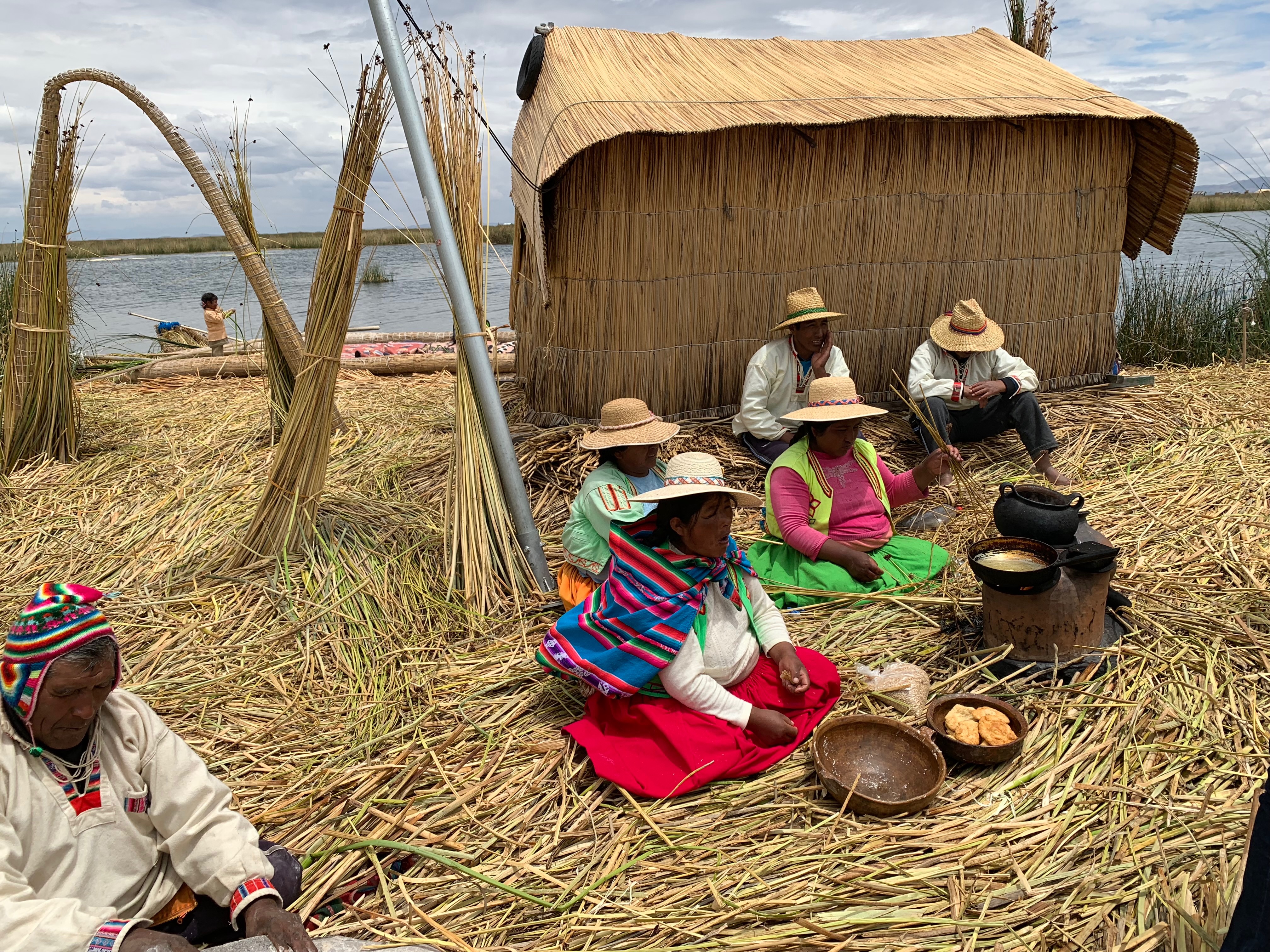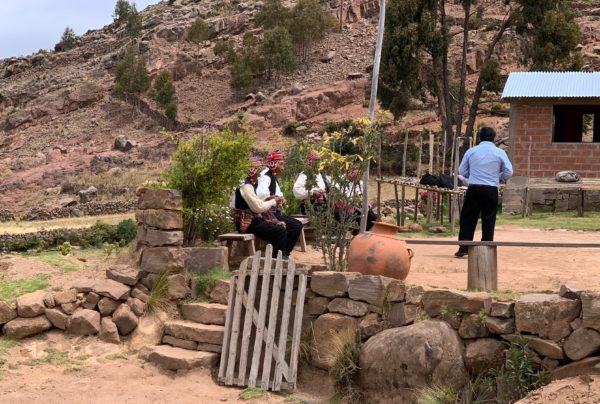
03 Nov TIO Peru: Lake Titicaca
Floating islands made out of reeds are home to a tribe that have lived there for centuries.

Approaching the reed island
On a nearby island of only 2.3 square miles 2,500 people live in a closed community where your hat tells people where you are at.

Approaching Taquile Island
Welcome to the world of Lake Titicaca, one of the last stops on our two-week tour of Peru.
Titicaca is located at 12,555 feet, making it the highest navigable lake in the world. It covers an area of 3,240 square miles and extends 118 miles in length and 49 miles in wide. The lake forms a natural border with Bolivia. (According to our guide Daisy, Peru got the “Titi”; Bolivia the “caca.”)
Titicaca is a geological wonder birthed during the pre-ice age about 60 million years ago. It was created when massive earthquakes shook the Andes Mountains splitting the range in two and forming a hollow that eventually got filled with water from the melting glaciers, creating bodies of water including Lake Titicaca, cradle of the Andean civilization.

On Lake Titicaca
According to an Andean legend, the lake gave birth to the sun – as well as to the father and mother of all the Incas. Pre-Inca Puraka and other cultures settled in the fertile land around the waters about 4,000 years ago. Later the Tiwuanaku culture emerged, dominating the region between 500 – 1,000 A.D. Shortly after the Incas came on the scene and populated the Altiplano and Bolivia. Warlike tribes like the Aymaras and the Collas who lived in the area were absorbed by the Incas who, instead of trying to obliterate competing cultures, tended to learn from their mergers (tribes that gave in without resistance) and conquests (those that did not bend so easily).
Having settled around its waters, the Incas and other indigenous cultures granted the lake sacred powers. Since that time, stories of Inca treasures and an underwater city, the legendary El Dorado, have attracted countless expeditions. In 1968, drawn by the myths, French explorer Jacques Cousteau undertook a one-and-a-half-month underwater search. He did not find the Lost City, but did manage to identify species of animals, including lots of toads and frogs, not found anywhere else in the world. Some would call that treasure.
In 2000, an international scientific group, Akakor Geographical Exploring, launched another expedition – “Atahualpa 2000 – and did find ruins belonging to the Tiwanaku culture of what appeared to be a temple and a submerged road dating back 1,000 to 1,500 years. Their conclusion? The temple was real, but it was not part of a submerged city. However, attempts to bring their find to surface have faced resistance from the local population who are superstitious about disturbing the waters of Lake Titicaca, which represents Pachamama or Mother Earth, whom they worship.
For us, home base on Lake Titicaca was a boutique lodge (only 18 rooms), which sits on a private peninsula: Titilaka.

View from Hotel Titilaka
Titilaka offers its guests a number of excursions daily, including a visit to the two aforementioned islands in a private boat. A group of about eight of us traveled about 1 1/2 hours to get away from the crowds on closer reed islands.
The Uros people have been living on the lake for hundreds of years, forced to take up residence on the floating islands when the Incas expanded onto their land. But the plan worked: Uros still speak their native Aymara, not Quechua. And, in the shadow of the Andes, they make their living fishing and selling reed handicrafts to tourists, who flock to one of about 70 man-made reed structures for a look at a much simpler way, somewhat exotic way of life.
Uros, as stated, are dependent on the totora reed, which is plentiful along the edges of the lake, and not just to make their homes, also their furniture and boats. As reeds disintegrate from the bottom of the islands, which are four- to eight-feet thick, residents add more to the surface, which is soft and occasionally spongy. Feels like walking on an uneven water bed.

Reed harvest

The cooking fire
That said, the Uros are not averse to modern amenities: on the island we visited, a solar panel powers a large, plasma TV in the “club” hut. The mini market where the women sell their weavings was just a few swaying steps away. (You are expected to bargain.)
Next stop on our boat outing was Taquile Island.
Taquile island (and the textiles it produces) were given protected status by UNESCO, so the place is high on the list what to check out on Lake Titicaca and in Peru in general.
The island’s inhabitants, known as Taquileños, live off the land through farming and fishing in a society based on collectivism. Its people have recently taken steps to gain greater control over the tourist trade which, according to local sources, sees over 40,000 visitors per year.

Taquile Island

Men in hats
Upon landing, our guide gave us the inside scoop on some of the practices unique to the community of gifted weavers. Hats (as we suggested above) play a unique role.
For example, when a young man is serious about his courting, he has to weave a hat. The hat is then given to his intended’s father, who turns it upside down and fills it with water. If the hat holds liquid for two minutes or more, he is good to go. If not, it is good-bye guy.
Women know which men are on the market based on the color and form of their hat, which identifies his relationship status. The general rules are this: a red-and-white hat means the man is single; red-and-blue means he is engaged; all red mean he is married. The direction of the tassel on the hat says whether a man is looking for a relationship or not – like the “looking around” status on dating websites.
In general, having nothing to do with dating rituals, when a pompom or tassel on a hat swings to the right, the wearer is happy; to the left, he is having a bad day. (Windy days can be very confusing.)
Hats aside, the women of Taquile Island announce their status with the color of their top: red means they are aged 17+ and married. Any other color and they are available.
Then there is the wedding belt. Daisy explained that women don’t just trust their men to keep the promises they make when proposing marriage. To feel secure, they weave those promises in the form of pictographs into a belt the man wears throughout their marriage. Images of a house, kids, job, money, etc. abound.
Marital traditions on Taquile ensure no divorce.
First the couple must live together for three years. (If a baby happens, then they have to marry early.)
After three years, assuming things have gone well, there is a marriage ceremony that lasts three days – during which time, the bride, now wearing 25 skirts, and the groom seated on the skin of a recently killed lamb, must sit absolutely still while everyone else gets down. It’s bad luck to move a muscle. (Which means the guy has to endure flea bites from the lamb skin without wincing.) Should the bride or groom have to go the bathroom, a parent is allowed to help.
After three days, the happy couple move into their home – which they are not allowed to leave for a full month. Or it’s bad luck.
Who would want to go through all that twice?
After Daisy’s illuminating talk, we hiked up to the top of the island for la banquet prepared by the locals.

View from the top of Taquile Island
A boat ride in the late afternoon on rough waters got us back to home base just in time for tea.
Or something stronger.
Then dinner, variations on the them of Andean cuisine prepared by master chefs, paired with wines from Chile, Argentina and Peru.

Morning view from the dining room
Like all our hotels, Titilaka seamlessly merges local assets, in this case, from surrounding Andean communities – even the maids went about their business looking like flowers dressed in traditional costumes from Copamaya and Santa Rose de Yanaque – with all the modern amenities anyone could ask for in a carbon-neutral environment.
Parting was such sweet sorrow.

From the entry hall, Titilaka


Sorry, the comment form is closed at this time.